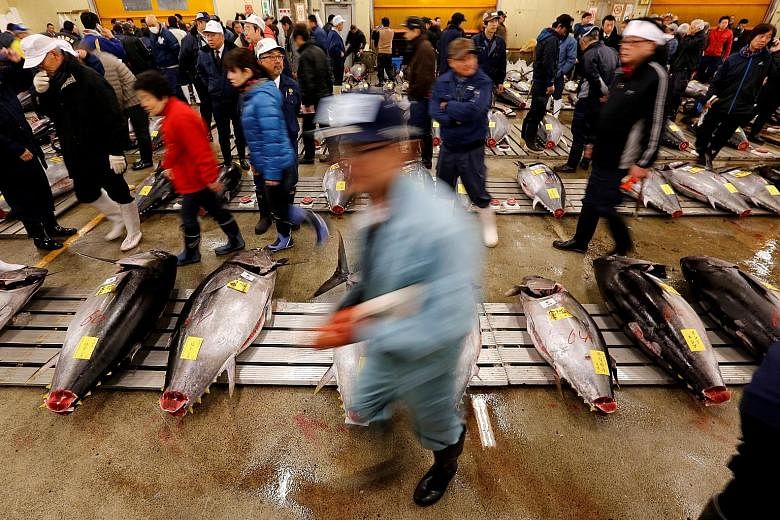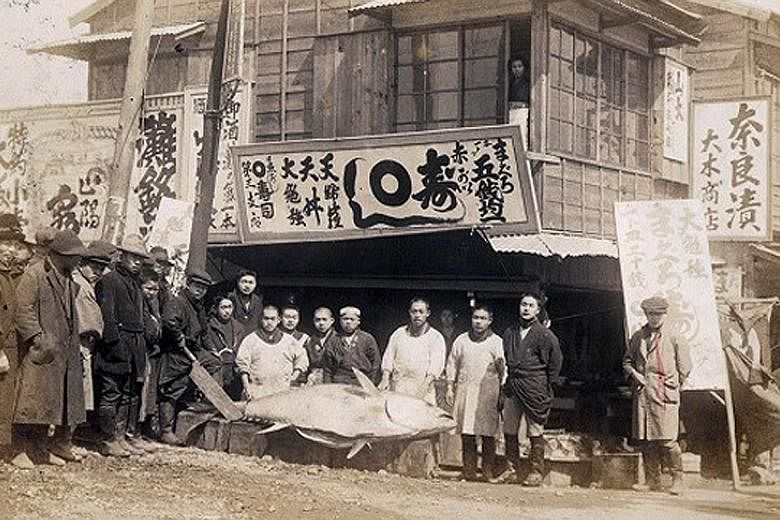Tokyo's famous Tsukiji fish market, the largest and busiest in the world, will go ahead with a move to a new site 2.3km away.
Tokyo Governor Yuriko Koike confirmed the move to the site in the Toyosu district yesterday, after it was shelved last year. But she disclosed that the fish market will move back within five years to its original but redeveloped site near the Ginza shopping district so as to leverage on its strong "brand".
This was a word Ms Koike emphasised many times at her news conference, saying it was "wisest to use both Toyosu and Tsukiji".
She did not disclose when the move will take place, saying she wanted to first come to an agreement with stakeholders on a timeline. But Japan's media has cited May next year as a plausible time.
Tokyo has pumped in billions of yen to build and clean up the new controversial bayfront site, where a gas plant used to stand.
The original plan was for a permanent move as the 82-year-old Tsukiji market is grappling with a surge in visitor numbers. As many as 42,000 people visit each day.
Only its inner market, famous for its early morning fish auctions and hole-in-the-wall eateries, is slated to make way for a major highway to ease congestion at the 2020 Tokyo Olympic Games.

-
Ebb and flow of major relocation
-
1985: The Tokyo Metropolitan Government (TMG) suggests renovating Tsukiji.
2001: Calling Tsukiji "too old, small and dangerous", then-governor Shintaro Ishihara says he would relocate instead of renovate.
2010: Toyosu, which housed a gas plant from 1956 to 1988, is announced as the new site
November 2014: TMG announces two years of tests to monitor Toyosu groundwater samples.
July 2015: Initial results show no issues, leading then-governor Yoichi Masuzoe to announce Nov 2, 2016 as the last day of operations at Tsukiji, and Toyosu is set to open five days later.
Aug 31, 2016: Governor Yuriko Koike, elected a month earlier, suspends the move saying it is "illogical" to do so before tests are fully complete.
Sept 10, 2016: Ms Koike reveals the new site is missing a layer of 4.5m-deep clean soil needed to insulate it from toxins.
Sept 2016 to May 2017: At least three sets of groundwater tests show carcinogens above safety levels.
June 20, 2017: Ms Koike confirms the temporary relocation of Tsukiji to Toyosu, with further safety measures to be taken.
Walter Sim
Ms Koike said its move is all the more needed given that the market's ageing structure is not earthquake-resistant.
But with its worldwide reputation, she said, it would make sense to eventually reopen the market alongside a "food theme park" that can offer culinary journeys.
She said: "Tsukiji has cultivated a brand over the decades and created a sense of community in the area. Wouldn't this be a way to make the best use of such an important treasure?"
Toyosu will be a "comprehensive logistics base", with its state-of-the-art refrigeration and cooling systems, as well as proximity to Narita and Haneda airports.
Her announcement ended months of confusion over the move - initially slated for November last year - which had been put on ice after groundwater tests showed excessive carcinogens at Toyosu.
Ms Koike, who was elected in July last year, had been aghast at inheriting a bureaucratic mess over a missing 4.5m-deep layer of fresh soil to protect the new site from toxins.
Yesterday, she acknowledged that the costs of building and maintaining Toyosu have already come up to about 600 billion yen (S$7.5 billion).
Clean-up costs add 86 billion yen to the bill, while businesses have said they are bleeding millions each day that the Toyosu site stands idle.
Ms Koike vowed to ensure the Toyosu site is safe by implementing more measures, including improvements to the groundwater pumping system.
Safety concerns have also cropped up at the Tsukiji site, after recent tests showed groundwater contamination to be above safety levels. But Tokyo has stressed the food is safe because of a layer of concrete covering the ground.
In 2015, some 1,628 tonnes of seafood worth about 1.6 billion yen passed through Tsukiji on average each day, according to a government document.


